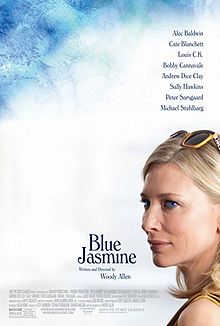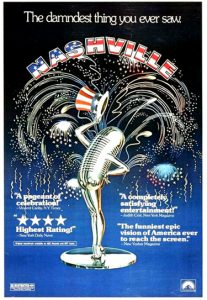Woody Allen’s Streetcar Named Desire
Review by Dan Geddes
Blue Jasmine is Woody Allen’s best movie since Vicky Cristina Barcelona (2008).
Blue Jasmine is a compelling retelling of Tennessee Williams’ A Streetcar Named Desire, but set in San Francisco and New York rather than in New Orleans. It’s not exactly the same story as Streetcar, but similar enough to draw comparisons. Jasmine is more drama than comedy, but some of the movie’s more devastating character insights will draw audience laughter.
Jasmine (Cate Blanchett) is the Blanche Dubois character: a once wealthy woman, who is thrown upon poverty and hard times. Now she’s going crazy, popping Xanax like mints and talking to herself in the street.
Jasmine had been married to Hal (Alec Baldwin), a suave Madoff-type crooked investor in New York. Hal is also charming with women, and Jasmine begins to suspect that he is cheating on her. Hal moved millions around in shell companies until the FBI arrests him one day without notice.
Desperate, Jasmine is forced to leave Manhattan to stay with her sister, Ginger (Sally Hawkins) in San Francisco. Ginger lives a humble, working-class existence. She is now divorced from Augie (Andrew Dice Clay), a handy-man and the father of her two boys.
In a flashback, we see that when Jasmine was rich, she could barely stand it the time that Ginger and Augie visited her in New York. (“Five days!” she repeats to herself, as if her sister’s visit is a prison sentence). She had the chauffeur drive them around, and spent very little time with them. However, when she learns that Augie has won $200,000 in the lottery, Jasmine suggests they give it to the crooked Hal to invest it for them (and they eventually lose it all).
Ginger and Augie’s loss of their lottery winnings appears to be the proximate cause of their divorce. Ginger is now dating Chili (Bobby Cannavale), who is the Stanley Kowalski character: the undershirt-wearing, bicep-baring, greasy-haired common man. Chili also seems to genuinely love her and wants to marry her. He knows that Jasmine despises them both, and that she is only there because she is desperate.
Jasmine decides to take a design course, but thinks it will be cheaper to first take a computer course and then study design online. At least she has a plan. To pay for the courses, she starts working as a dentist’s receptionist, a stressful position that she is ill-suited for. While Chili might see working for a dentist as a step up, for Jasmine it is demeaning, especially when the leering dentist, Dr. Flicker (Michael Stuhlbarg from the Coen Brothers’ A Serious Man) puts the moves on her.
Days later at a party, Jasmine is lucky to meet Dwight (Peter Sarsgaard), a rich, ambassador-type, who falls for her svelte figure in little Chanel numbers. He wants to take her to Vienna and treat her to her accustomed level of comfort. We are sort of relieved for her because we know that this may be the only way she can survive and retain her sanity. But on the other hand, she doesn’t deserve it, and she is quick to openly despise Ginger as soon as she seems to have a better deal in hand.
#
Blue Jasmine is mainly a meditation on class in contemporary America. Jasmine’s mental illness appears to be almost entirely the result of her fixation on appearances (elitism). She is so disdainful of Ginger’s normal life in her actually cozy-looking San Francisco apartment (“How can you live like this?”) that it’s hard to believe she grew up in the same modest circumstances as her sister. Jasmine’s horror with Hal’s cheating on her seems more focused on what her social circle will think about it than her own feeling of being betrayed in her marriage. Some of the working class characters, such as Ginger, Augie and even Chili, come off as more authentic than the rich folks (though Chili hounding Ginger at work is a bit ominous). Clay’s Augie exudes sincerity and credibility despite his weird, net-like salt-and-pepper hair. Twenty years ago, who would have predicted Andrew Dice Clay turning in a great job in a serious role in a Woody Allen movie?
Allen does well by generally following the Streetcar story arc of Jasmine’s disintegration. He uses flashbacks well, so that the back story of Jasmine’s marriage destruction has its own climax. However, the Dwight storyline is a bit clunky, as it’s hard to believe that a guy that rich and smart would fail to detect some of Jasmine’s craziness with his own eyes, or would not bother to at least Google her as a basic background check before serious committing himself to her (when he has political ambitions). Also, the scene outside the jewelry store is a little bit too coincidental. But look for another Academy Award screenplay nomination (original or adapted?) for Allen, who already has the most screenplay nominations in Oscar history.
Cate Blanchett’s performance as Jasmine is Oscar-caliber. She is raw emotion, but can still usually compose herself if anyone classy is around. Her desperate pill-popping and drinking recall her performance as Jude Quinn, the amphetamine-gobbling Bob Dylan (c. 1966) in I’m Not There (2007). Her character here is almost entirely evasive: she is unwilling to confront Hal even when she suspects that he’s breaking the law with his pyramid of paper companies. She’s so preoccupied with her fall from affluence that can’t even pretend to be interested in Ginger’s life or children. She clings to her designer clothes as the last vestiges of her former self.
Sally Hawkins also turns in a great performance as the working class sister, Ginger, who is so much more likeable and healthier as a human being than the class-obsessed Jasmine. Ginger is content with normal guys, first with Augie and later with Chili. Only Jasmine’s berating her to seek out “better” men leads her to a party where she meets Al, who seems like a nice guy. Louis C.K. is suitably funny and oozes all the right, false nice-guy vibes as Ginger’s paramour, Al, who gives Ginger her own conflict.
One big difference with Streetcar is that Chili has no sexual attraction for Jasmine. He knows that he has the better of the two (adopted) sisters with Ginger, and simply wants Jasmine to leave.
The production design is sharp, whether of Jasmine’s opulent Manhattan townhouse, her Hamptons beach house, Dwight’s stunning Bay Area house, or Ginger’s modest San Francisco apartment.
Woody Allen, who has been shooting his latest movies in Europe, here depicts San Francisco, perhaps America’s most European city, and one of its last streetcar cities. Working from the story template of A Streetcar Named Desire his script focuses on the class signifiers of contemporary Americans, and how this obsession can be fatal to true emotion and happiness.
21 September 2013






Be First to Comment